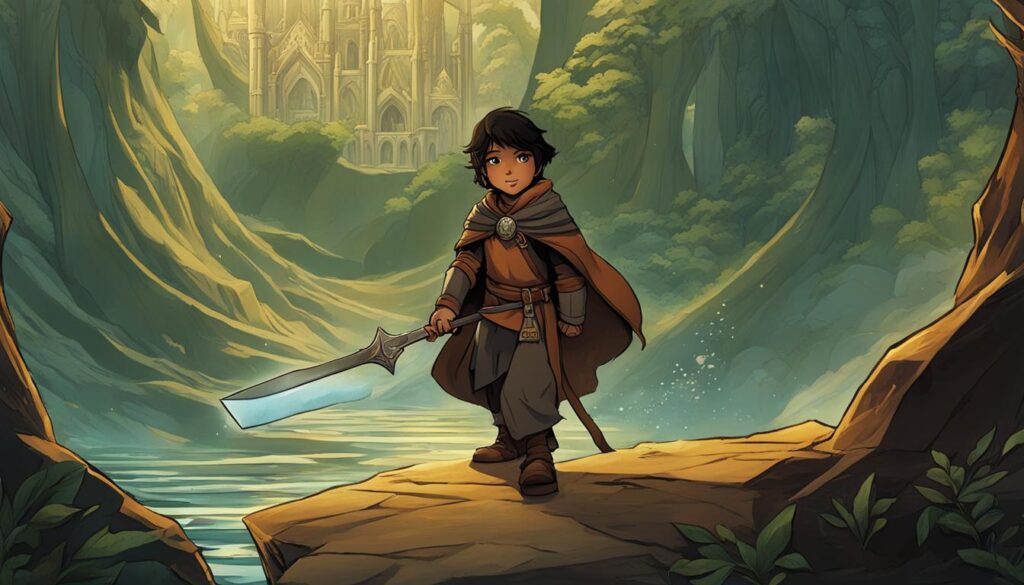If you’re a fan of fantasy fiction, you’ve probably heard of the Sevenwaters Series by internationally acclaimed author Juliet Marillier. The third book in this series, Child of the Prophecy, is a must-read page-turner that leaves readers spellbound.
In this book summary, we dive deep into the world of Sevenwaters and explore the plot, characters, setting, and themes that make Child of the Prophecy a standout novel. Whether you’re new to the series or a devoted fan, you won’t want to miss this book summary.
About the Author, Juliet Marillier
Juliet Marillier is an award-winning New Zealand author of fantasy, historical fiction, and young adult novels. Born in 1948 in Dunedin, New Zealand, Marillier earned a degree in languages and music before embarking on a career as a music teacher and performer. In the early 2000s, she began writing novels, becoming a full-time author in 2009.
Marillier is known for her richly-layered, character-driven storytelling, drawing inspiration from her Celtic roots and love of mythology. She has published over twenty novels to date, with notable works including the Sevenwaters Series, the Blackthorn & Grim Series, and the Shadowfell Trilogy. Her stories often explore themes of love, loyalty, and the human experience, earning her a legion of devoted fans around the world.
Introduction to the Sevenwaters Series
The Sevenwaters Series is a collection of historical fantasy novels written by Juliet Marillier. The series takes place in ancient Ireland and follows the lives and adventures of the Sevenwaters family and those closely connected to them. Each book in the series is standalone but shares the same world and characters.
The Sevenwaters Series consists of six novels, with the third book being Child of the Prophecy. The other books in the series are:
- Daughter of the Forest
- Son of the Shadows
- Child of the Prophecy
- Heir to Sevenwaters
- Seer of Sevenwaters
- Flame of Sevenwaters
Each novel explores different themes and storylines while maintaining the overall tone and atmosphere of the Sevenwaters world. Fans of historical fantasy, Celtic mythology, and strong female protagonists are sure to enjoy this series.
Plot Overview
Child of the Prophecy by Juliet Marillier is a tale of love, sacrifice, and destiny. The story is set in medieval Ireland, where the forests of Sevenwaters have always been wild and dryads, spirits, and other magical beings are said to reside. The novel follows the life of the protagonist, Fainne, who is the daughter of Niamh, a sorceress, and Ciaran, a druid. Fainne is lured into the service of her evil grandmother, the sorceress Lady Oonagh, who seeks to use Fainne’s powers to achieve her dark ambitions.
The plot revolves around Fainne’s struggle to uncover the truth about her family and her destiny. She meets Darragh, a warrior of the Tuatha Dé Danann, and they fall deeply in love. Along the way, Fainne faces many challenges, including her own doubts and fears, as well as the forces that Lady Oonagh has unleashed. Fainne must choose between love and duty, honor and magic, and ultimately face the consequences of her decisions.
Marillier weaves a magical tale that is both captivating and heart-wrenching. The plot is filled with twists and turns, and the characters are complex and multi-dimensional. The novel explores themes of identity, loyalty, and the consequences of the choices we make. Overall, Child of the Prophecy is a beautifully written story that will keep you turning the pages till the very end.

Main Characters
Child of the Prophecy boasts a rich array of characters who bring the narrative to life. Let’s take a look at the key players:
| Character | Description |
|---|---|
| Sibeal | A young druid who dreams of becoming a priestess. She becomes close with Fainne and helps her on her journey. |
| Fainne | The protagonist of the story. She is the daughter of Niamh and Ciaran, granddaughter of Sorcha, and is raised by her father in Kerry. She is destined to play a pivotal role in the preservation of the Old Ones. |
| Ciaran | Fainne’s father, who has a complicated past and struggles to come to terms with his own guilt and grief. |
| Liadan | Sorcha’s daughter and Fainne’s aunt. She is married to Bran and has two children, Niamh and Sean. |
| Bran | Liadan’s husband and a skilled warrior. He is deeply dedicated to his family and the preservation of the Old Ones. |
These characters and their relationships with one another provide the emotional backbone of the novel, making it a truly engrossing read.
Setting and World-Building
The setting of Sevenwaters is an essential aspect of the narrative in Child of the Prophecy. The story takes place in Ireland, during a time when the land was divided into several small kingdoms, each with their own rulers and customs. The author masterfully weaves together the historical context of this period with fantastical elements, drawing the reader into a rich and vibrant world.
The world-building in Child of the Prophecy is equally impressive. The author creates a complex mythology, complete with its own set of legends, rituals, and gods. The story’s magical elements are based on this mythology, which is seamlessly integrated into the characters’ lives and the plot.
A particular focus of the world-building is the relationship between the mortal world and the Otherworld. The Otherworld is a realm inhabited by supernatural beings, such as faeries and spirits, and is closely connected with the natural world. The author uses this connection to underscore the importance of harmony with nature and the power of human agency to impact the environment.
Overall, the setting and world-building in Child of the Prophecy are masterfully crafted and play a significant role in the narrative. The author’s attention to detail creates a vivid and immersive world that readers will delight in exploring.
Themes and Symbolism
In Child of the Prophecy, Juliet Marillier masterfully weaves together various themes and symbolism to create a layered and engaging story. The book explores themes such as destiny, sacrifice, and the power of family connections.
The ancient Celtic culture and mythology that serve as the foundation of the story add depth and richness to the symbolism present in the novel. For instance, the swan, which is a significant symbol in Celtic mythology, is used throughout the book to represent transformation and the power of love.
Destiny
One of the central themes in Child of the Prophecy is the idea of destiny. The story follows Fainne, a young woman who is faced with the daunting task of fulfilling a prophecy that has been foretold about her since birth. As she navigates the challenges and sacrifices that come with this destiny, the novel explores the larger question of whether our fates are predetermined or if we have control over our own lives.
The recurring imagery of the three ancient rocks, which represent the three fates in Celtic mythology, further underscores the theme of destiny. Fainne struggles with the idea of being bound to this prophecy, while at the same time feeling a sense of duty to see it through.
Sacrifice
Sacrifice is another prominent theme in the book. Several characters in the story make significant sacrifices for the greater good, highlighting the lengths that people will go to protect their loved ones and ensure a better future for their community.
In particular, Fainne’s journey of self-discovery and the sacrifices she makes along the way highlight the complex nature of sacrifice. The book presents the idea that sometimes, in order to create something new and better, we must be willing to give up something of equal value.
Family Connections
Family connections are a central part of the story in Child of the Prophecy. The novel explores the complex relationships between family members and the various ways in which they can be both a source of strength and a source of conflict.
The bond between parents and children is a particularly significant theme in the novel. Fainne’s relationship with her father, Ciaran, is one of the driving forces of the story. Their connection, both strong and complicated, illustrates the lengths that parents will go to protect their children and provide them with the best possible life.

“The symbols used in Child of the Prophecy not only complement the plot but also add another layer of meaning to the story, making it a truly unforgettable read.”
Writing Style and Narrative Techniques
Juliet Marillier is known for her beautiful writing style, which can be characterized as lyrical, descriptive, and evocative. Her writing style is particularly effective in creating vivid, immersive settings that transport the reader to another time and place. The descriptive language she employs imbues her narratives with a sense of atmosphere that is essential to the story and the world-building.
Moreover, Marillier’s use of narrative techniques adds depth to her storytelling. One of the most notable techniques she employs is the use of multiple perspectives. In Child of the Prophecy, this technique allows for a more nuanced exploration of the story’s themes and characters. The reader is able to gain insight into the perspectives of various characters, each with their own motivations and struggles.
“Her prose has a fairy-tale quality that transports readers to another time and place, and her ability to create complex, relatable characters is unmatched.”
Another effective technique that Marillier uses is foreshadowing. This technique is used throughout the novel to build tension and suspense, keeping the reader engaged and guessing about what will happen next. By subtly hinting at future events, Marillier creates a sense of anticipation that adds to the overall reading experience.
Overall, Marillier’s writing style and narrative techniques are integral to the success of Child of the Prophecy. Her powerful prose and effective use of multiple perspectives and foreshadowing help to create a compelling, thought-provoking story that will stay with readers long after they’ve finished the book.
Reception and Critiques
Child of the Prophecy received widespread critical acclaim upon its release, with many critics lauding Juliet Marillier’s writing style and storytelling abilities. Fans of the Sevenwaters Series praised the book for its vivid characters, immersive setting, and exploration of complex themes.
Some critics, however, expressed disappointment with the slow pacing of the novel and criticized certain plot points as predictable. Others felt that the book was too reliant on the previous installments in the series and didn’t stand well on its own.
“Marillier’s skillful prose transports readers into a richly imagined world, filled with vivid characters and compelling themes. Child of the Prophecy is a stunning achievement in epic fantasy literature.” – Booklist
Despite some mixed reviews, Child of the Prophecy remains a beloved entry in the Sevenwaters Series and a testament to Juliet Marillier’s talent as a storyteller.
Conclusion
Child of the Prophecy by Juliet Marillier is a must-read for fans of the Sevenwaters Series. With its complex characters, gripping plot, and thought-provoking themes, this book delivers on every level. Marillier’s writing style and narrative techniques add depth to the story, making it a truly immersive experience. From the lush setting to the intricate world-building, every aspect of the novel is expertly crafted.
While the book has received some critiques, overall, it has been well-received by readers. Whether you are new to the series or a long-time fan, Child of the Prophecy is a novel that is sure to leave an impression. In this book summary, we have provided an overview of the key aspects of the novel, from the plot to the main characters to the themes and symbolism. We hope that this summary has been helpful in giving you a better understanding of this compelling story.



